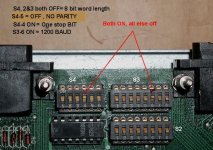Hugo Holden
Veteran Member
It can be very frustrating getting the serial link working, for the first time at least.
If you go to the SOL-20 org site, the .ENT files are there , you just click on them and on my computer the file just appears on the VDU, you can save it or copy and paste it into notepad.
http://sol20.org/programs.html
When the serial link is not working, initially at least, there are a lot of variables that could stop it: Incorrect cable wiring, a hardware fault in the SOL ,including defective IC's and faulty DIP switches. Then there is incorrect settings of the switches in the SOL, or incorrect settings in Teraterm.
Since we know for a fact that the cable arrangement I posted works (at least with my computer with a real RS-232 serial port) and that Teraterm definitely works, you could try getting that cable arrangement, using a computer with a serial port (mine is just a 2004 vintage HP pavillion running XP) then try again, making sure that if you send a .ENT file you use the SEND option in Teraterm (not the TRANSFER option, Xmodem etc which is used for transferring .COM and .ASM files etc).
Then if that still does not work it would narrow it down to a hardware fault in the SOL, or incorrect switch settings in the SOL or a bad DIP switch, faulty IC , UART or transceiver IC track modifications, breakage etc .
My SOL did have a fault with one on the Serial transceiver IC's also it had a defective DIP switch, these transceiver IC's can get damaged by electrostatic discharges from long cables or voltage transients caused by hot plugging if the peripheral device does not have is common lines at ground potential.There are also reports of the UART's failing.
In any case, with the sol, its easy to put the scope on the input pin of the UART, to see if the data is arriving there. And using the TERM command, easy to see if the sol is able to send data to the "terminal" to confirm a two way link is working.
If you go to the SOL-20 org site, the .ENT files are there , you just click on them and on my computer the file just appears on the VDU, you can save it or copy and paste it into notepad.
http://sol20.org/programs.html
When the serial link is not working, initially at least, there are a lot of variables that could stop it: Incorrect cable wiring, a hardware fault in the SOL ,including defective IC's and faulty DIP switches. Then there is incorrect settings of the switches in the SOL, or incorrect settings in Teraterm.
Since we know for a fact that the cable arrangement I posted works (at least with my computer with a real RS-232 serial port) and that Teraterm definitely works, you could try getting that cable arrangement, using a computer with a serial port (mine is just a 2004 vintage HP pavillion running XP) then try again, making sure that if you send a .ENT file you use the SEND option in Teraterm (not the TRANSFER option, Xmodem etc which is used for transferring .COM and .ASM files etc).
Then if that still does not work it would narrow it down to a hardware fault in the SOL, or incorrect switch settings in the SOL or a bad DIP switch, faulty IC , UART or transceiver IC track modifications, breakage etc .
My SOL did have a fault with one on the Serial transceiver IC's also it had a defective DIP switch, these transceiver IC's can get damaged by electrostatic discharges from long cables or voltage transients caused by hot plugging if the peripheral device does not have is common lines at ground potential.There are also reports of the UART's failing.
In any case, with the sol, its easy to put the scope on the input pin of the UART, to see if the data is arriving there. And using the TERM command, easy to see if the sol is able to send data to the "terminal" to confirm a two way link is working.

